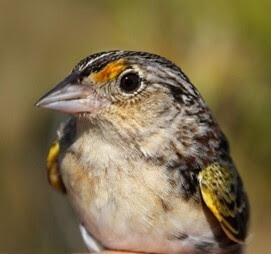Florida grasshopper sparrow, one of North America’s rarest, most endangered birds, saved from brink of extinction
Florida Fish and Wildlife Conservation Commission (FWC)
As the sun rose over the central Florida prairie on July 16, 2024, a tiny bird took a tentative hop into conservation history. If you blinked, you might have missed the release of the 1,000th conservation-bred Florida grasshopper sparrow into the wild, marking a major milestone for one of North America’s most endangered birds. Accompanied by nine other sparrows, the 1,000th sparrow joined its wild counterparts at Avon Park Air Force Range.
A decade ago, the Florida grasshopper sparrow population was on the brink of extinction due to habitat loss and other threats. In response, the Florida Fish and Wildlife Conservation Commission (FWC), U.S. Fish and Wildlife Service, White Oak Conservation, Fish & Wildlife Foundation of Florida, U.S. Air Force, and other partners launched a comprehensive conservation and recovery program.
“The recovery and release program diverted the extinction of the Florida grasshopper sparrow,” said Adrienne Fitzwilliam, lead sparrow research scientist at the FWC’s Fish and Wildlife Research Institute. “The success of such a considerable effort has been possible due to continued collaboration.” Partners have dedicated substantial resources to the recovery of the Florida grasshopper sparrow, including funds from the foundation’s “Conserve Wildlife” license plate, and it’s having an impact.
Since the releases began in May 2019, the wild sparrow population has more than doubled. At the initial release site, Three Lakes Wildlife Management Area, the population increased from only 11 breeding pairs in 2018 to at least 37 in 2023. Birds released as juveniles not only survived but also successfully mated and had baby sparrows. Although the releases are not a long-term solution, the population increase allows partners time to research possible landscape-level solutions.
Avon Park Air Force Range was added as a release site in 2021. “The release of the 1,000th Florida grasshopper sparrow at Avon Park Air Force Range is a great example of the Air Force’s ability to both enhance our wildlife and natural resources on Department of Defense land while at the same time achieving our goal of providing sustainable and world-class military training,” said Dr. Kris Pitcher, natural resource manager at Avon Park Air Force Range. The population at the range has adjusted quickly, with released birds remaining onsite and successfully breeding.
“Learning how to breed Florida grasshopper sparrows in captivity, and then how to successfully release them back into the landscape has taken a lot experimenting -- a lot of trial-and-error,” said Larry Williams, state supervisor for the U.S. Fish and Wildlife Service in Florida. “We’ve gained incredible insight into the specific and nuanced needs of Florida grasshopper sparrows, and those insights are helping people around the country be more effective at bird conservation.”
The conservation breeding program has expanded beyond White Oak Conservation to include the Avian Preservation and Education Conservancy, Santa Fe College and Brevard Zoo, with support from the Welaka National Fish Hatchery. “While more work needs to be done in the years ahead, we can be proud that our rearing and release programs have kept alive the distinct buzz of the Florida grasshopper sparrows on the prairies of central Florida,” said Andrew Schumann, conservation and recovery program manager for White Oak Conservation.
In addition to expanding partnerships and conservation efforts like nest protection, the fate of the Florida grasshopper sparrow is tied to habitat conservation. A crown jewel in that effort is the protection of the 27,000 acre DeLuca Preserve in Osceola County, with 6,000 acres of sparrow habitat, home to one of the largest known breeding populations at a critical location in the Florida Wildlife Corridor. “Conserving land is pivotal in saving the Florida grasshopper sparrow from extinction,” said Andrew Walker, president and CEO of the Fish & Wildlife Foundation of Florida. “These little birds represent a big beacon of hope that our commitment, partnership and holistic approach can save vulnerable wildlife from the brink of extinction.”
